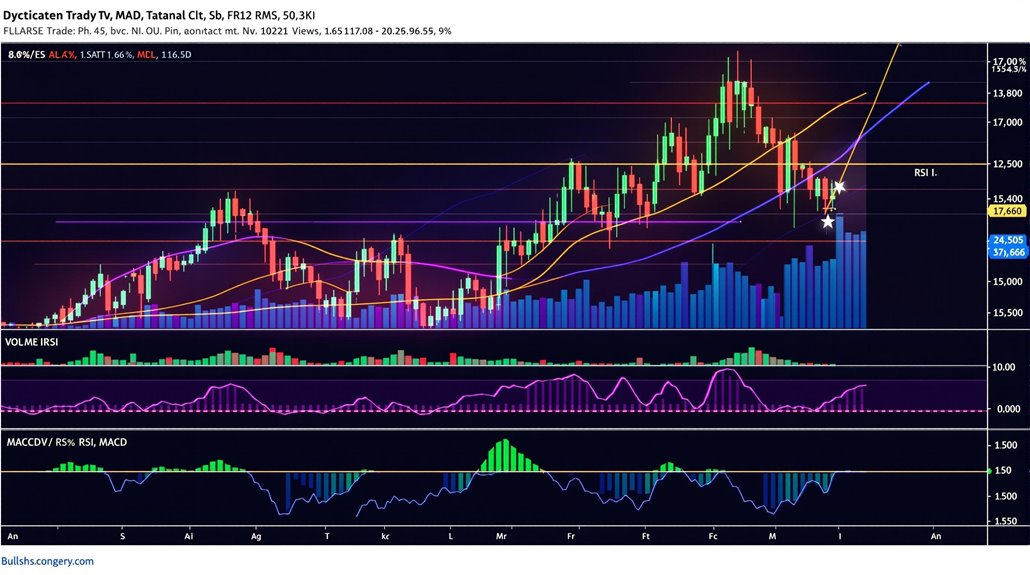Technical analysis employs systematic evaluation of price action, chart patterns, and mathematical indicators to identify ideal market entry and exit points through historical data examination. Successful market timing requires mastery of essential components including support/resistance levels, volume analysis, and pattern recognition, combined with robust risk management protocols and disciplined trade execution strategies. Understanding these fundamental building blocks enables traders to develop thorough frameworks for consistently profitable market operations.
Key Takeaways
- Price action combined with volume analysis confirms genuine market movements and helps identify optimal entry/exit timing points.
- Technical indicators like RSI and MACD provide mathematical validation of market conditions and help time trend reversals.
- Chart patterns including triangles, flags, and head-and-shoulders formations signal potential market direction and timing opportunities.
- Support and resistance levels create psychological barriers where price action often reacts, providing timing signals for trades.
- Multiple timeframe analysis strengthens timing decisions by confirming trends and potential reversals across different market perspectives.
The Building Blocks of Technical Analysis

Technical analysis, a cornerstone of modern market trading, rests upon five fundamental building blocks that form its analytical framework: price action analysis, volume analysis, technical indicators, time frames, and pattern recognition.
Each component serves a distinct yet interconnected purpose in thorough trend analysis. Price action analysis examines historical price behavior through candlestick and bar charts, revealing vital support and resistance zones that inform trading decisions. Modern traders leverage sophisticated charting software to enhance their technical analysis capabilities and research.
Technical analysis integrates multiple elements to decode market behavior, with price action revealing critical trading zones through historical chart patterns.
Volume analysis validates price movements by measuring trading activity intensity, while technical indicators provide mathematical confirmation of market conditions through tools like RSI and MACD. The overbought and oversold conditions identified by these indicators help traders spot potential market reversals and generate reliable trading signals.
Time frame selection determines the analytical perspective, with shorter intervals serving active traders and longer periods benefiting strategic investors.
Pattern recognition focuses on identifying trend continuations and shifts through trendline analysis and consolidation phases, enabling traders to anticipate potential market movements with greater precision.
Essential Chart Patterns Every Trader Should Know
Technical analysts consider specific geometric price formations to be reliable indicators of future market direction, with triangles, flags, and head and shoulders patterns among the most significant.
These formations manifest through distinct price action characteristics: triangles exhibit converging trendlines indicating consolidation, flags display brief rectangular consolidations following strong moves, and head and shoulders patterns feature three peaks signaling potential trend reversals. Traders closely monitor support and resistance levels to confirm pattern validity and determine optimal entry points.
Volume analysis provides critical confirmation of pattern reliability when making trading decisions. Statistical research validates the predictive capacity of these patterns, with ascending triangles demonstrating a 75% success rate in forecasting continued uptrends, while head and shoulders breakdowns frequently precede substantial downward price movement.
Triangle and Flag Formations
Among the most reliable predictive tools in technical analysis, triangle and flag formations represent essential chart patterns that skilled traders regularly employ to identify potential market movements and trend continuations.
Triangle analysis reveals three distinct formations – ascending, descending, and symmetrical – each providing unique market insights through converging trendlines and volume characteristics.
Flag identification focuses on parallel trendlines forming rectangles or parallelograms that move counter to the primary trend, typically following a strong price movement known as the flagpole. High and tight flag patterns require a steep upward movement before consolidation, making them particularly powerful bullish signals.
These formations offer traders precise entry points with clearly defined risk parameters, particularly when confirmed by volume analysis at breakout points. Understanding support and resistance levels helps traders validate the strength of these chart patterns.
Both patterns demonstrate high reliability when properly identified, with triangle patterns projecting targets based on their widest points and flags utilizing flagpole length for price objectives.
Head and Shoulders Patterns
Building upon the predictive power of geometric formations, the head and shoulders pattern stands as one of the most recognized and statistically reliable chart configurations in market analysis.
This classical pattern recognition framework consists of three distinctive peaks, with the central peak (head) rising above two roughly symmetrical outer peaks (shoulders).
When traders identify this formation, particularly during established trends, it frequently signals an impending trend reversal.
The pattern’s completion occurs when price action penetrates the neckline—a critical support level connecting the troughs between the shoulders and head.
Successful traders often use psychological price levels to confirm potential support or resistance at the neckline before making trading decisions.
Trading strategies typically involve positioning after the neckline breach, with profit targets calculated by projecting the head-to-neckline distance from the breakout point.
For enhanced reliability, analysts often integrate volume analysis and multiple timeframe confirmation before executing positions based on this formation. This powerful technical indicator has proven to be one of the most reliable reversal patterns in technical analysis when properly identified.
Mastering Support and Resistance Levels

Mastering the fundamentals of support and resistance stands as a cornerstone requirement for successful technical analysis in financial markets. These critical price levels serve as dynamic indicators where market psychology manifests through predictable price reversals and breakout patterns.
- Support strategies incorporate historical significance by identifying price floors through trend analysis of previous market bottoms, while resistance techniques focus on established ceiling levels where selling pressure typically intensifies. Moving average crossovers can provide additional confirmation when identifying key support and resistance zones.
- Trading signals generated at these psychological barriers gain validity through multiple tests, with each successful bounce reinforcing the strength of the support or resistance level.
- Dynamic levels constantly evolve as markets move, requiring traders to adapt their analysis by incorporating both static price points and moving technical indicators. The interaction between buyers and sellers at these key levels creates supply and demand zones that directly influence price movements.
Understanding these technical concepts enables traders to anticipate potential market turning points and develop precise entry and exit strategies aligned with institutional trading patterns.
Key Technical Indicators for Market Timing
Technical analysis practitioners rely on a sophisticated arsenal of mathematical indicators to enhance the precision and reliability of their market timing decisions. The strategic implementation of these indicators facilitates data-driven trading choices based on quantifiable market behavior rather than subjective interpretation.
Moving averages serve as foundational tools for identifying trend direction and potential reversal points, with variations like simple and exponential averages offering distinct analytical advantages. EMA calculations heavily weight recent price data to provide more responsive trend signals.
The Relative Strength Index (RSI) complements trend analysis by measuring momentum and identifying overbought or oversold conditions between 0 and 100. The MACD histogram helps visualize momentum shifts by displaying the difference between fast and slow moving averages. Advanced traders often synthesize multiple indicators, combining MACD for trend confirmation, Bollinger Bands for volatility assessment, and Stochastic Oscillators for timing precision.
This thorough approach enables market participants to triangulate high-probability entry and exit points while maintaining rigorous risk management protocols. The systematic application of these technical indicators provides traders with a structured framework for executing disciplined market timing strategies.
Volume Analysis and Market Psychology

Volume analysis serves as a critical confirmation tool for price movements, providing insight into the conviction behind market trends through measurement of trading activity and participation levels.
Professional traders actively monitor volume indicators to make informed trading decisions based on changing market dynamics. The psychological underpinnings of volume patterns reveal the collective sentiment of market participants, with increasing volume during price advances typically indicating strong bullish conviction, while declining volume often signals waning momentum or potential trend reversal.
Understanding the relationship between volume and price action enables traders to distinguish between genuine market moves and false signals, while offering valuable perspective on institutional versus retail participation in specific market movements. Tools like VWAP analysis help traders identify key support and resistance levels where significant trading activity occurs.
Volume Confirms Price Action
A fundamental pillar of market analysis lies in understanding how trading volume confirms and validates price movements, serving as a critical gauge of market psychology and conviction behind directional changes.
The correlation between volume trend and price action provides essential insights into the sustainability of market movements, while volume momentum serves as a reliable indicator of trend strength and potential reversals. Market analysis during overbought conditions typically reveals reversals in oscillator direction, signaling potential trend changes ahead. RSI divergence patterns provide additional confirmation when price movements deviate from underlying momentum signals.
- Rising prices accompanied by increasing volume demonstrate robust buyer conviction and trend sustainability.
- Volume divergence against price direction signals potential trend exhaustion or imminent reversal.
- Significant volume spikes at key technical levels validate breakouts and authenticate market turning points.
Technical analysts integrate volume analysis with other indicators to formulate thorough trading strategies, recognizing that strong volume confirms legitimate price movements while weak volume suggests unsustainable market activity.
Trading Psychology Behind Volume
Understanding market psychology through volume analysis reveals fundamental behavioral patterns that drive financial markets and shape trading decisions. Volume patterns serve as vital participation indicators that expose underlying market sentiment and trading emotions.
When analyzing volume spikes, traders can identify psychological thresholds where herd mentality manifests through collective buying or selling pressure. These emotional extremes often coincide with significant price movements, particularly during breakouts or market reversals. The Volume Flow Indicator helps traders quantify and interpret these psychological shifts in real-time.
Institutional investors’ actions become visible through elevated trading volumes, while periods of low volume may signal indecision or lack of conviction. Recognizing contrarian opportunities emerges when volume patterns contradict prevailing market sentiment, potentially signaling a shift in crowd behavior.
Seasoned analysts recognize that divergences between price action and volume can expose unsustainable trends driven by irrational exuberance or fear, enabling more informed decision-making based on objective market psychology assessment.
Creating a Technical Trading Strategy
Developing a robust technical trading strategy requires careful consideration of multiple interconnected components that work harmoniously to produce consistent results in financial markets.
Strategy execution and trade management form the cornerstone of a systematic approach that aligns with predefined objectives while maintaining disciplined risk parameters. Understanding how to read candlestick charts is essential for accurately timing market entries and exits. Maintaining risk-reward ratios helps ensure systematic decision-making across all trading activities.
Disciplined trade management and systematic strategy execution create the foundation for achieving consistent results within defined risk boundaries.
- Define specific market parameters, including asset class selection, timeframe preferences, and quantifiable performance metrics that align with individual trading goals.
- Integrate complementary technical indicators while avoiding redundancy, utilizing price action, volume analysis, and momentum measurements for thorough market evaluation.
- Establish precise entry and exit protocols based on objective criteria, incorporating protective stop-loss mechanisms and profit targets derived from historical price behavior.
The implementation phase demands rigorous backtesting across various market conditions, followed by continuous monitoring and refinement of strategy parameters to guarantee peak performance as market dynamics evolve.
Risk Management in Technical Trading
Risk management stands as the cornerstone of successful technical trading, serving as the critical foundation that protects capital and enables sustained market participation through disciplined decision-making protocols.
A thorough risk assessment framework incorporates multiple protective layers, including position sizing that adheres to the 1% rule for capital allocation, and strategic implementation of stop-loss and take-profit orders to maintain controlled market exposure. Successful traders know that planning ahead first prevents emotional trading decisions that can derail even the most sophisticated strategies.
Technical traders must establish clear volatility measures and risk tolerance parameters before execution, utilizing both static and trailing stops to prevent catastrophic losses while protecting accumulated gains.
Order execution discipline demands strict adherence to pre-established trade parameters, with diversification across uncorrelated assets serving as a critical loss prevention mechanism.
Success requires systematic analysis of win-loss ratios and average payoff sizes to maintain positive expectancy, while regular strategy evaluation ensures adaptation to evolving market conditions without compromising fundamental risk management principles.
Combining Technical and Fundamental Approaches
While technical analysis and fundamental analysis are often viewed as competing methodologies, successful traders recognize the powerful synergy created by integrating both approaches into a thorough analytical framework.
The integrated analysis approach leverages complementary strengths to generate more reliable trading signals and improve risk-adjusted returns. Moving averages including 15- and 21-day timeframes provide crucial short-term trend validation when combined with fundamental data.
- Technical indicators provide precise entry and exit points while fundamental analysis validates the underlying market direction, creating market synergy through multi-dimensional confirmation.
- Economic releases and earnings reports serve as fundamental catalysts, while technical patterns help optimize trade timing and position sizing.
- Volume analysis combined with fundamental trends enables traders to validate price movements and assess the strength of market momentum.
This extensive methodology enhances trading outcomes by reducing false signals and providing multiple confirmation points before executing trades.
Traders implementing both approaches benefit from increased analytical depth and more robust decision-making frameworks.
Frequently Asked Questions
How Long Does It Typically Take to Become Proficient in Technical Analysis?
Achieving proficiency in technical analysis typically requires 1-2 years of dedicated study and practical application.
The learning curve varies based on individual commitment, with beginners needing several months to master fundamental concepts through regular practice sessions.
Advanced competency demands consistent engagement with market dynamics, sophisticated analytical tools, and thorough risk management strategies.
Most successful analysts continue their education indefinitely to adapt to evolving market conditions and technological innovations.
Can Technical Analysis Be Effectively Applied to Cryptocurrency Markets?
Technical analysis can be effectively applied to cryptocurrency markets, as evidenced by empirical studies showing success rates of 43-45% for combined indicator strategies.
Despite heightened cryptocurrency volatility, traders leverage market psychology through established indicators like MACD, RSI, and moving averages to identify potential trends and reversals.
Research demonstrates that multi-indicator approaches typically achieve win/loss ratios between 1.17:1 and 1.5:1, though success requires adapting traditional methods to account for crypto-specific market dynamics.
What Percentage of Professional Traders Rely Primarily on Technical Analysis?
Like skilled architects constructing a complex building, professional traders weave together multiple analytical approaches.
According to industry data, approximately 30-40% of professional traders rely primarily on technical analysis for their trading decisions, though rarely using it exclusively.
Most combine technical indicators with fundamental analysis, risk management strategies, and market context assessment.
Major institutions, including investment banks and hedge funds, maintain dedicated technical analysis teams while incorporating other methodologies into their thorough trading frameworks.
How Often Should Technical Analysis Indicators Be Recalibrated for Market Changes?
The ideal frequency of technical indicator adjustments depends primarily on market volatility and trading timeframes.
Daily or intraday recalibration suits high-frequency strategies, while swing traders may adjust weekly or monthly.
Asset-specific characteristics and market conditions dictate precise calibration schedules – highly volatile markets require more frequent adjustments, while stable trends permit longer intervals between recalibrations.
Professional traders typically implement systematic recalibration protocols aligned with their specific trading methodology and market environment.
Does Technical Analysis Perform Better in Bull or Bear Market Conditions?
While fear and volatility plague bear markets, bull markets offer fertile ground for technical analysis success.
Research demonstrates that technical analysis performs especially better during bull markets due to several key advantages: sustained trends, clearer support/resistance levels, and more reliable momentum indicators.
Bear market challenges include increased false signals, erratic price action, and psychological factors that disrupt pattern formation.
Historical data shows bull markets’ longer duration (42 months versus 19 months) provides more stable conditions for technical strategies to succeed.
Conclusion
Technical analysis serves as a powerful compass for guiding the turbulent waters of market timing. By integrating chart patterns, support and resistance levels, key indicators, and volume analysis into a cohesive strategy, traders can make more informed decisions while maintaining disciplined risk management. When combined with fundamental analysis, this thorough approach provides market participants with a robust framework for identifying potential trading opportunities across various market conditions.
References
- https://corporatefinanceinstitute.com/resources/career-map/sell-side/capital-markets/technical-analysis/
- https://www.youtube.com/watch?v=BUCPPCXOHbs
- https://www.investopedia.com/terms/t/technicalanalysis.asp
- https://cfi.trade/en/vu/blog/trading/technical-and-fundamental-analysis-a-beginners-guide
- https://www.investopedia.com/articles/active-trading/043015/market-timing-tips-rules-every-investor-should-know.asp
- https://pepperstone.com/en/learn-to-trade/trading-guides/fundamental-vs-technical-approaches/
- https://www.cmegroup.com/education/courses/technical-analysis/fundamental-analysis-vs-technical-analysis.html
- https://www.investopedia.com/articles/trading/07/technical-fundamental.asp
- https://www.youtube.com/watch?v=u2KwNXtOIrM
- https://www.etoro.com/trading/technical-fundamental-and-quantitative-analysis/

